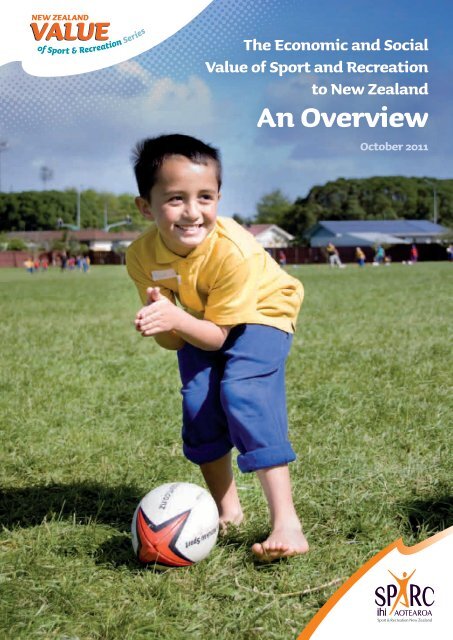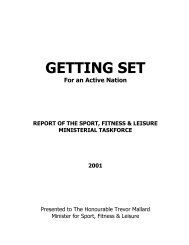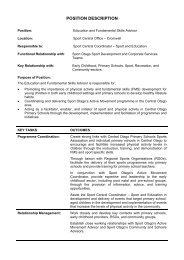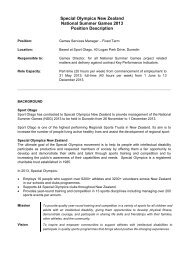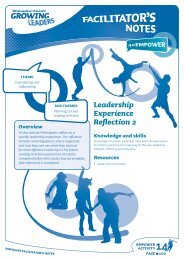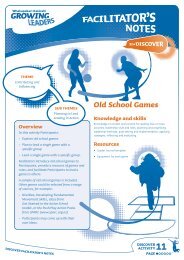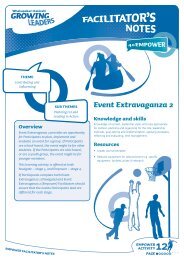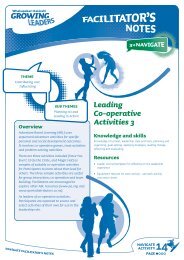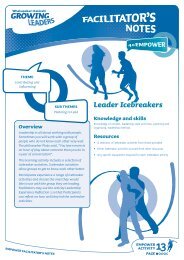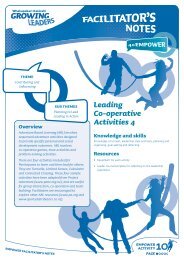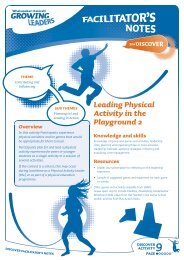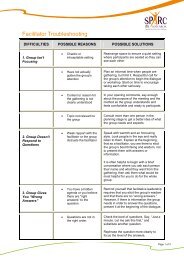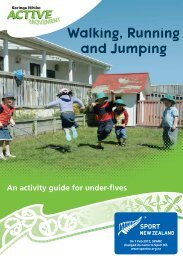An Overview - Sport New Zealand
An Overview - Sport New Zealand
An Overview - Sport New Zealand
Create successful ePaper yourself
Turn your PDF publications into a flip-book with our unique Google optimized e-Paper software.
The Economic and Social<br />
Value of <strong>Sport</strong> and Recreation<br />
to <strong>New</strong> <strong>Zealand</strong><br />
<strong>An</strong> <strong>Overview</strong><br />
October 2011
Acknowledgements<br />
This publication is based on a full report prepared for SPARC by the AERU at Lincoln<br />
University titled The Economic and Social Value of <strong>Sport</strong> and Recreation to <strong>New</strong> <strong>Zealand</strong>.<br />
We are pleased to acknowledge the AERU team: Professor Caroline Saunders and Dr Peter<br />
Tait, led by the report’s author Professor Paul Dalziel. We also thank Chris Schilling, Peter<br />
Clough and Dr Jagadish Guria (<strong>New</strong> <strong>Zealand</strong> Institute of Economic Research, NZIER) who<br />
prepared for SPARC a preliminary analysis on the value of sport and recreation in <strong>New</strong><br />
<strong>Zealand</strong>. Agnes Guevara (ACC) provided data on sport injury claims and <strong>An</strong>drew McLaren<br />
(Statistics <strong>New</strong> <strong>Zealand</strong>) provided data from the 2006 Census on employment. Alistair<br />
Gray (Statistics Research Associates Ltd) and the National Research Bureau Ltd assisted in<br />
analysis of data produced in the 2007/08 Active <strong>New</strong> <strong>Zealand</strong> Survey. Within SPARC, the<br />
project was led by Grant McLean and Dr Sue Walker, with data analysis assisted by Dr Maea<br />
Hohepa. The project team is particularly grateful to Professor Chris Gratton (<strong>Sport</strong> Industry<br />
Research Centre, Sheffield Hallam University) whose review of an early draft of the original<br />
report was very important in shaping the report’s final structure and some of its content.<br />
Author<br />
This overview was written by Professor Paul Dalziel with editorial assistance by SPARC.<br />
Copies of the full report can be downloaded from SPARC’s website: www.sparc.org.nz.<br />
Citation:<br />
SPARC, 2011. The Economic and Social Value of <strong>Sport</strong> and Recreation to <strong>New</strong> <strong>Zealand</strong>: <strong>An</strong><br />
<strong>Overview</strong>. Wellington: SPARC.<br />
Cover Photo:<br />
Credit: Auckland <strong>Sport</strong>s Photography<br />
ISBN: 1-877356-19-3<br />
Published in 2011 by SPARC (<strong>Sport</strong> and Recreation <strong>New</strong> <strong>Zealand</strong>).
THE VALUE OF SPORT<br />
1<br />
Foreword<br />
I am pleased to present this report on The Economic and Social Value of <strong>Sport</strong> to<br />
<strong>New</strong> <strong>Zealand</strong>: <strong>An</strong> <strong>Overview</strong> by Professor Paul Dalziel, Professor of Economics at the<br />
AERU Research Unit at Lincoln University.<br />
The work delivers on a commitment in SPARC’s 2009-2015 Strategic Plan to<br />
investigate and measure the value sport and recreation brings to the nation in terms<br />
of economic benefits, health savings and social and cultural gains.<br />
This new work has good foundations. It builds on and extends earlier work for<br />
SPARC’s predecessor, the Hillary Commission, by BERL (Business and Economic<br />
Research Ltd) and incorporates preliminary work for SPARC by NZIER. It also draws on<br />
and extends international studies. I thank Professor Dalziel for the considerable time<br />
and effort that has gone into this study.<br />
Professor Dalziel’s work shows that the sector is much larger and its contribution<br />
to GDP (Gross Domestic Product) substantially greater than previous studies have<br />
shown. The market value of sport and recreation to the <strong>New</strong> <strong>Zealand</strong> economy in<br />
2008/09 is estimated to be $5.2 billion, or 2.8 per cent of GDP. This puts the<br />
sector on a par with the dairy industry’s contribution to the <strong>New</strong> <strong>Zealand</strong> economy. 1<br />
The estimate of market value tells only part of the story. This new study shows that<br />
sport and active recreation result in gains in productivity and health benefits valued<br />
at $1.0 billion. Putting a dollar value on the personal benefits of participating in sport<br />
and recreation adds a further $6 billion, bringing Professor Dalziel’s overall estimate<br />
of the value of the sector to <strong>New</strong> <strong>Zealand</strong>ers to $12.2 billion.<br />
The study also estimates that the tax revenue from the sector is two and a half<br />
times that of government expenditure. This represents an excellent return on the<br />
Government’s investment.<br />
These are impressive figures and will provide sport and recreation organisations, local<br />
councils, commercial enterprises and government agencies with the hard facts they<br />
need to make sound investment decisions and leverage more resources. The results<br />
will also allow the sector to demonstrate how sport and recreation can help generate<br />
jobs, income, exports and sustainable local economies, and contribute to <strong>New</strong><br />
<strong>Zealand</strong>‘s international profile.<br />
SPARC knows that sport and recreation is not just about economic benefits and<br />
a companion report – Value of <strong>Sport</strong> and Recreation: Case Study of Northern<br />
United Rugby Football Club 2 – illustrates some of the personal and social values for<br />
individuals, families and communities from taking part in sport.<br />
Peter Miskimmin<br />
Chief Executive, SPARC<br />
1<br />
A 2010 study by NZIER estimated that the dairy sector<br />
accounts for 2.8% of GDP, or $5 billion.<br />
2<br />
This study was by Research <strong>New</strong> <strong>Zealand</strong> and the report<br />
is on SPARC’s website.
2<br />
Contents<br />
Foreword..........................................................................................................1<br />
List of Tables................................................................................................... 3<br />
List of Figures ................................................................................................ 3<br />
Summary......................................................................................................... 4<br />
1. Introduction................................................................................................ 6<br />
2. Valuing <strong>Sport</strong> and Recreation in <strong>New</strong> <strong>Zealand</strong>....................................... 9<br />
How is economic activity valued?................................................................. 9<br />
The market value of sport and recreation to the economy.......................... 10<br />
The total value of sport and recreation to the economy.............................. 11<br />
3. The <strong>Sport</strong> and Recreation Sector – Narrowly Defined.......................... 12<br />
4. The <strong>Sport</strong> and Recreation Sector – Broadly Defined ............................14<br />
The contribution of the wider employment sector ......................................14<br />
The contribution of spending on sport and recreation education ................16<br />
The contribution of local government..........................................................16<br />
The contribution to GDP from the sport and recreation sector<br />
– broadly defined ....................................................................................... 17<br />
The contribution of volunteers.....................................................................18<br />
5. Social Benefits of <strong>Sport</strong> and Recreation ................................................19<br />
Calculating productivity and health benefits ...............................................19<br />
Calculating personal benefits.......................................................................21<br />
6. Conclusion ................................................................................................23<br />
Tracking progress .......................................................................................24<br />
Improving data sources and estimates ....................................................... 24<br />
Appendix: Key Facts and Estimates............................................................ 25
THE VALUE OF SPORT<br />
3<br />
Tables<br />
Table 1: Employment in sport and recreation industries, 2006................... 12<br />
Table 2: Contribution to GDP of sport and recreation industries, 2006/07 .... 13<br />
Table 3:<br />
Contribution to GDP of the sport and recreation sector<br />
– broadly defined, 2008/09 .......................................................... 17<br />
Table 4: GDP including the value of volunteered services, 2008/09 ............ 18<br />
Table 5: Direct benefits and costs from participation, 2009........................ 19<br />
Table 6: Total time spent by all adults in sport and recreation, 2009 .......... 22<br />
Figures<br />
Figure 1: Calculating a sector’s value added................................................. 9<br />
Figure 2:<br />
Figure 3:<br />
Estimated market value of sport and recreation in <strong>New</strong> <strong>Zealand</strong>,<br />
2008/09 ..................................................................................... 10<br />
Estimated total value of sport and recreation in <strong>New</strong> <strong>Zealand</strong>,<br />
2008/09...................................................................................... 11<br />
Figure 4: Employment in sport and recreation occupations, 2006 ............... 15<br />
Figure 5: Total employment in the sport and recreation sector, 2006 .......... 15<br />
Figure 6:<br />
Local government net spending on sport and recreation<br />
facilities, 2003-2009..................................................................... 16<br />
Figure 7: Personal benefits and costs of participation ................................. 21
4<br />
Summary<br />
<strong>Sport</strong> and recreation activities are highly valued by <strong>New</strong> <strong>Zealand</strong>ers<br />
• 9 out of 10 (92%) young people and 8 out of 10 (83%) adults take part<br />
in one or more sport and recreation activities (see page 25 for more details).<br />
• There are more than 15,000 sport and recreation clubs in <strong>New</strong> <strong>Zealand</strong>.<br />
• These are supported by over three-quarters of a million (776,000) volunteers.<br />
<strong>Sport</strong> and recreation industries are important generators of jobs<br />
for <strong>New</strong> <strong>Zealand</strong>ers<br />
• Over 35,000 people (36,831) work in sport and recreation industries.<br />
• This is larger than the house construction industry (36,093 people).<br />
• Adding in the number of people working in sport and recreation occupations<br />
(outside the sport and recreation industries) the total goes up to almost<br />
50,000 (48,363).<br />
<strong>Sport</strong> and recreation industries contribute to the <strong>New</strong> <strong>Zealand</strong> economy<br />
• The sport and recreation sector (narrowly defined) contributed $3.8<br />
billion to GDP in 2008/09, or 2.1 per cent.<br />
• This is larger than the accommodation, restaurants and bars sector ($3.6 billion).<br />
<strong>Sport</strong> and recreation occupations provide income to <strong>New</strong> <strong>Zealand</strong>ers<br />
• Over 25,000 (25,251) people work in sport and recreation occupations.<br />
• The total annual personal income for people in sport and recreation<br />
occupations is estimated to have been $875 million (measured in 2009 values).<br />
<strong>Sport</strong> and recreation education is important in <strong>New</strong> <strong>Zealand</strong> schools<br />
• Just over five per cent of The <strong>New</strong> <strong>Zealand</strong> Curriculum is related to sport and<br />
recreation.<br />
• This same share of teacher salaries in 2008/09 adds up to $172 million.
THE VALUE OF SPORT<br />
5<br />
<strong>Sport</strong> and recreation facilities are a large investment by <strong>New</strong><br />
<strong>Zealand</strong> local governments<br />
• Councils spent $345 million on new sport and recreation facilities in 2008/09.<br />
• This contributed $100 million to the value of the construction sector that year.<br />
<strong>Sport</strong> and recreation volunteers contribute valuable services to<br />
<strong>New</strong> <strong>Zealand</strong>ers<br />
• Volunteers contributed over 50 million (51.3 million) hours to sport and<br />
recreation in 2007/08.<br />
• The estimated market value of these volunteered services is over $700<br />
million ($728 million at 2009 values).<br />
<strong>Sport</strong> and recreation provide additional social benefits to <strong>New</strong><br />
<strong>Zealand</strong><br />
• Increased work productivity and better health outcomes, minus the costs<br />
of serious sport and recreation accidents, produced social benefits of $1.0<br />
billion in 2009.<br />
• Direct benefits enjoyed by participants in sport and recreation are estimated<br />
to be a further $5.9 billion.<br />
<strong>Sport</strong> and recreation activities are an important part of <strong>New</strong><br />
<strong>Zealand</strong>’s tax base<br />
• The sport and recreation sector (broadly defined) contributed $4.5 billion to<br />
GDP in 2008/09, or 2.4 per cent.<br />
• This is estimated to have generated tax revenue of $1.3 billion.<br />
<strong>Sport</strong> and recreation are an important economic sector in <strong>New</strong><br />
<strong>Zealand</strong><br />
• The contribution of sport and recreation to GDP (including volunteered<br />
services) in 2008/09 was more than $5.2 billion, or 2.8 per cent.<br />
• This is as large as a recent estimate of the contribution made to GDP by the<br />
dairy sector.<br />
• Including the value of social and personal benefits, the total value of sport<br />
and recreation to <strong>New</strong> <strong>Zealand</strong>ers is around $12.2 billion.
6<br />
1. Introduction<br />
<strong>New</strong> <strong>Zealand</strong>ers value sport and recreation<br />
15,000+ sport and<br />
recreation clubs<br />
<strong>New</strong> <strong>Zealand</strong>ers love<br />
sport – 9 out of 10<br />
young people and 8 out<br />
of 10 adults take part in<br />
sport and recreation<br />
2 million tickets sold to<br />
sports events<br />
<strong>Sport</strong>s events have<br />
a significant impact.<br />
Westpac stadium,<br />
for example,<br />
contributed $48<br />
million to Wellington’s<br />
economy in 2009/10<br />
and supported over<br />
600 jobs<br />
500 elite athletes<br />
1,000 professional<br />
sports people<br />
Consider a typical weekend in <strong>New</strong> <strong>Zealand</strong>. Before dawn, sleepers in<br />
Department of Conservation huts wake up and prepare for a day of<br />
tramping, climbing or hunting. In towns and cities, rowers begin arriving at<br />
smooth stretches of water to prepare for training or racing, and swimmers<br />
begin their early morning schedule of conditioning work. Throughout the<br />
country, cyclists and runners eat a carefully considered breakfast before<br />
setting out on their week’s long distance exercise.<br />
As the morning progresses, playing fields, stadiums and gymnasiums up and<br />
down the country are filled by tens of thousands of young people engaged<br />
in sport competitions, spurred on by large numbers of parents and siblings<br />
supporting them on the sidelines. At different times of the year, some of<br />
these young people are picked for representative teams that travel to<br />
participate in national tournaments.<br />
As morning turns into afternoon, sport and recreation involving adult<br />
participants become more common. The recreation includes a wide range of<br />
water-based activity on rivers or lakes, in harbours or at the beach, or in<br />
public or private swimming pools. It also includes families travelling to<br />
regional parks for bike trails or walking tracks. The sport includes a wide<br />
range of social competitions, but also top-grade contests for which the<br />
participants (including the contest officials) have trained seriously during the<br />
week. After these events, club rooms everywhere provide opportunities for<br />
members to socialise and talk about what they have done or watched.<br />
<strong>Sport</strong> and recreation activities continue into the evening. It is a rare Saturday,<br />
for example, when there is no night-time horse racing. National competitions<br />
involving team franchises or provincial representative teams often include<br />
evening events to increase the size of the television audience. These national<br />
competitions are typically organised by professional sports administrators<br />
and many of the participants receive at least some financial reward. All day,<br />
however, thousands of people are involved as volunteers, helping<br />
participants of all ages get the most from their activities.<br />
In some parts of the country, local professional or volunteer organisers may<br />
have arranged a special event or tournament that attracts hundreds of<br />
visitors as participants or spectators. This includes fun runs, marathons, road<br />
cycle races, yachting or rowing regattas, masters sporting tournaments,<br />
annual regional or national championships, and the like.<br />
The weekend will typically include one or more sports events involving<br />
individuals or teams selected to represent <strong>New</strong> <strong>Zealand</strong>. For some contests,<br />
the media will have been in a frenzy for days, reporting on individual form<br />
and making predictions about the outcome. The event may be watched by<br />
an audience of hundreds of thousands of <strong>New</strong> <strong>Zealand</strong>ers, and will be the<br />
subject of much debate afterwards. Overnight and for the rest of the week,<br />
broadcasters and journalists will prepare and publish commentary eagerly<br />
consumed by supporters.
THE VALUE OF SPORT<br />
7<br />
The importance of valuing the benefits of<br />
sport and recreation<br />
<strong>Sport</strong> and recreation are highly valued in <strong>New</strong> <strong>Zealand</strong>. Individuals and<br />
communities invest considerable amounts of time and money in sport and<br />
recreation. There are more than 15,000 sport and recreation clubs at a local<br />
level, supported by approximately 776,000 volunteers. Large areas of <strong>New</strong><br />
<strong>Zealand</strong> are managed by the Department of Conservation ‘for conservation,<br />
scientific and recreational purposes’. Local councils invest billions of dollars<br />
in indoor and outdoor sport and recreation facilities that cater for everyone,<br />
from youngsters first learning to chase after a ball to professional athletes<br />
competing in front of a television audience of millions. Community clubs and<br />
private businesses complement these public facilities by providing their own<br />
goods and services to <strong>New</strong> <strong>Zealand</strong>ers engaged in sport and recreation.<br />
Given this high level of public and private investment, it is important to have<br />
some shared understanding of the benefits (minus any costs) produced by<br />
participation in sport and recreation. This is recognised internationally, where<br />
there is considerable interest in valuing the benefits of sport and recreation.<br />
In Europe, for example, researchers and statisticians are working towards<br />
creating <strong>Sport</strong> Satellite Accounts (which sit alongside the National Accounts)<br />
for countries in the European Union. More generally, it is now commonplace<br />
for provinces and regions around the world to commission studies on the<br />
contribution of sport and recreation to their local economies.<br />
Consequently, SPARC commissioned Professor Paul Dalziel to prepare a<br />
comprehensive framework to value the benefits of sport and recreation in<br />
<strong>New</strong> <strong>Zealand</strong>. The framework was designed to be consistent with similar<br />
overseas research and it used the latest available data.<br />
These new estimates update those from studies carried<br />
out more than a decade ago for the Hillary<br />
Commission. The work also drew on a more recent<br />
preliminary analysis completed for SPARC by NZIER.<br />
A full copy of the AERU report The Economic and Social<br />
Value of <strong>Sport</strong> and Recreation to <strong>New</strong> <strong>Zealand</strong> (which<br />
includes much more detail, including information<br />
about data sources and reports referred to here)<br />
can be downloaded from the SPARC website.<br />
On an average day,<br />
200,000 people watch<br />
rugby, netball and<br />
tennis matches on TV<br />
One-third of <strong>New</strong><br />
<strong>Zealand</strong>’s total land<br />
area is managed by<br />
the Department of<br />
Conservation<br />
<strong>New</strong> <strong>Zealand</strong><br />
households spend<br />
$1.3 billion on sports<br />
goods and equipment<br />
– as much as they spend<br />
on dining out<br />
Central government<br />
spends $500 million on<br />
sport and recreation
8<br />
Report content<br />
Following this introduction, section 2 provides an overview of the main results.<br />
Sections 3 to 5 then describe how the economic and social value of sport and<br />
recreation in <strong>New</strong> <strong>Zealand</strong> has been estimated in three steps.<br />
1. The first step focuses on industries producing goods and services directly<br />
for participants in sport and recreation (this provides an estimate for a<br />
narrow definition of the sector).<br />
2. The second step broadens the definition of the sector to include four items:<br />
a) .the contribution of people who are employed in sport and recreation<br />
.occupations but outside the sport and recreation industries<br />
considered in step one;<br />
b) .central government investment associated with the delivery of the<br />
.sport and recreation components of The <strong>New</strong> <strong>Zealand</strong> Curriculum in<br />
schools;<br />
c) .local council investment in new sport and recreation facilities; and<br />
d) the contribution of sport and recreation volunteers.<br />
3. The third step considers the increased productivity and health benefits<br />
from taking part in sport and recreation, and other social and personal<br />
benefits enjoyed by participants that justify the amount of time they<br />
spend on sport and recreation.<br />
The report finishes in section 6 with a proposed set of indicators that can be<br />
used to track progress of the value of sport and recreation to <strong>New</strong> <strong>Zealand</strong> in<br />
future.
THE VALUE OF SPORT<br />
9<br />
2. Valuing <strong>Sport</strong> and<br />
Recreation in <strong>New</strong> <strong>Zealand</strong><br />
How is economic activity valued?<br />
When national statisticians estimate the value of an economic activity, they<br />
use a technique known as value added. Consider a single enterprise, such as<br />
a farm. During a year, the farm might earn revenue from sales of livestock<br />
of $1,000,000 but might make payments totalling $600,000 to suppliers of<br />
goods and services used by the farm, such as feed, fencing posts, veterinary<br />
services and financial advice. These ‘inputs’ are provided by other enterprises,<br />
and so the farm’s ‘value added’ is $400,000. It is the difference between<br />
total revenue and total payments, and is the source of the wages and salaries<br />
paid to the farm’s employees, as well as the profits earned by the farm’s<br />
owners.<br />
Sales of $1,000,000<br />
minus costs of $600,000<br />
(for goods and services<br />
used in production) =<br />
value added of $400,000<br />
This same approach can be applied to an industry or sector of the economy<br />
(see Figure 1). The value added by the farming sector is calculated by adding<br />
up the total revenues of all the farms in the country and then subtracting<br />
all the total payments made by the farms. If we add up the value added in<br />
all the economy’s sectors, this produces the statistic called gross domestic<br />
product (better known as GDP). The most common measure of a sector’s<br />
size is the amount of its value added expressed as a percentage of GDP, since<br />
this is the sector’s share of the total value added in the national economy.<br />
Figure 1<br />
Calculating a sector’s value added<br />
VALUE<br />
ADDED<br />
TOTAL<br />
REVENUE<br />
TOTAL<br />
PAYMENTS<br />
Using this approach, it is possible to estimate the size of the sport and<br />
recreation sector’s contribution (or value added) to <strong>New</strong> <strong>Zealand</strong>’s GDP.<br />
Following overseas studies, this estimate can be based on a narrow definition<br />
of the sector or on a broader definition that is more encompassing.
10<br />
The market value<br />
of sport and<br />
recreation to the <strong>New</strong><br />
<strong>Zealand</strong> economy is<br />
$5.2 billion<br />
or 2.8% of GDP<br />
The market value of sport and recreation to<br />
the economy<br />
The sport and recreation sector accounts for $5.2 billion or 2.8 per cent of<br />
GDP. This is the market value using a broad definition of the sector. How this<br />
estimate is calculated is explained below and illustrated in Figure 2.<br />
Figure 2<br />
Estimated market value of sport and recreation in <strong>New</strong> <strong>Zealand</strong>, 2008/09<br />
17 <strong>Sport</strong> and<br />
Recreation Industries<br />
$3,844 million<br />
(2.1% of GDP)<br />
Plus $672 million<br />
Physical and Human<br />
Infrastructure<br />
= $4,516 million<br />
(2.4% of GDP)<br />
Plus $728 million<br />
Market Value<br />
of Volunteers<br />
= $5,244 million<br />
(2.8% of GDP)<br />
Plus $ ???<br />
Value of other<br />
industries reliant<br />
on <strong>Sport</strong> and<br />
Recreation activities<br />
(not measured)<br />
Estimated market value is $5,244 million or 2.8% of GDP<br />
The inner oval in Figure 2 shows the value added by 17 industries that<br />
produce goods and services necessary for sport and recreation (see Table 1 in<br />
Section 3). This is the narrowest definition of the sport and recreation sector.<br />
In 2008/09, these industries contributed $3.8 billion or 2.1 per cent to <strong>New</strong><br />
<strong>Zealand</strong>’s GDP.<br />
The second oval includes an additional $672 million from:<br />
(i) incomes of people working in sport and recreation occupations outside<br />
of the 17 industries – for example, a recreation guide employed by a hotel<br />
(hospitality industry);<br />
(ii) investment by central government in sport and recreation education in<br />
schools; and<br />
(iii) local councils’ expenditure on new sport and recreation facilities.<br />
This begins to broaden the definition of the sector and takes the contribution to<br />
$4.5 billion or 2.4 per cent of GDP.<br />
The third oval takes into account volunteered services, which are particularly<br />
important in the sport and recreation sector. The additional $728 million comes<br />
from assigning a volunteer wage rate of $14.19 per hour to the 51.3 million<br />
hours volunteers spend supporting sport and recreation over a year. This takes<br />
the contribution of the sport and recreation sector to $5.2 billion or 2.8 per<br />
cent of GDP (including volunteered services).<br />
These are conservative estimates because the study was not able to find data<br />
to measure everything that the sport and recreation sector contributes to the<br />
economy (for example, from sports broadcasting). This feature of the study is<br />
reflected in the figure’s final oval, for which there is no value at present.
THE VALUE OF SPORT<br />
11<br />
The total value of sport and recreation to<br />
the economy<br />
The study was able to extend the economic measure in Figure 2 with<br />
estimates of the social and personal benefits from participation in sport and<br />
recreation, the non-market value. This takes the estimate of the total value<br />
of sport and recreation to <strong>New</strong> <strong>Zealand</strong> to over $12 billion ($12,192 million).<br />
How this estimate is calculated is explained below and illustrated in Figure 3.<br />
Figure 3<br />
Estimated total value of sport and recreation in <strong>New</strong> <strong>Zealand</strong>, 2008/09<br />
The total benefits from<br />
sport and recreation<br />
are valued at over<br />
$12 billion<br />
Measured Market<br />
Value of <strong>Sport</strong><br />
and Recreation<br />
$5,244 million<br />
Plus $1,038 million<br />
Productivity and<br />
Health Benefits<br />
= $6,282 million<br />
Plus a further<br />
$5,910 million<br />
Opportunity Cost<br />
of Time in <strong>Sport</strong><br />
and Recreation<br />
= $12,192 million<br />
Plus $ ???<br />
Unmeasured Market<br />
Values and non-<br />
Market (Social and<br />
Personal) Benefits<br />
from <strong>Sport</strong> and<br />
Recreation<br />
Estimated total value (market and non-market) is $12,192 million<br />
In Figure 3 the first oval shows the market value of sport and recreation in<br />
2008/09. This figure is the same as that shown in the third oval in Figure 2.<br />
The market value is only part of the picture. Physically active people have<br />
higher work productivity and better health outcomes than people who<br />
are not active. The 2007/08 Active <strong>New</strong> <strong>Zealand</strong> Survey found that 20 per<br />
cent of adults are physically active because of participation in sport and<br />
recreation. Estimating a dollar value of this group’s increased productivity<br />
and improved health, minus the costs from accidental deaths and serious<br />
sport and recreation injuries, produces an estimate of additional benefits of<br />
$1.0 billion, shown in the second oval of Figure 3.<br />
People spend a large amount of time participating in sport and recreation<br />
(including acting as volunteers or watching young people play organised<br />
sport). This participation must produce personal benefits to justify this time,<br />
which could be spent in other beneficial activities. The study uses <strong>New</strong><br />
<strong>Zealand</strong>’s statutory minimum wage to value this time, which produces a<br />
further $5.9 billion of net personal benefits, as shown in the third oval.<br />
20% of adults get<br />
the benefits of being<br />
active by taking part<br />
in sport and recreation<br />
Adults spend 400<br />
million hours a year<br />
taking part in sport<br />
and recreation<br />
Family time – adults<br />
spend 75 million hours<br />
watching children play<br />
sport<br />
As in the previous diagram, these first three ovals do not include everything<br />
that the sport and recreation sector contributes to the national economy,<br />
leaving a fourth oval with no estimate of the value at present.<br />
Sections 3 to 5 explain in more detail how the estimates in Figures 2 and 3<br />
have been calculated.
12<br />
3. The <strong>Sport</strong> and Recreation<br />
Sector - Narrowly Defined<br />
<strong>New</strong> <strong>Zealand</strong>ers value sport and recreation<br />
Over 36,000 people<br />
work in sport and<br />
recreation industries<br />
– more than work in<br />
construction and on<br />
dairy farms<br />
Note: The list in Table 1 is<br />
conservative. Although some<br />
industries include activities that are<br />
not within the scope of this study<br />
(for example, some people employed<br />
in some amusement parks), this is<br />
balanced by the exclusion of other<br />
industries that have a large sport<br />
and recreation component (such as<br />
sports journalists or people employed<br />
in the broadcasting industry who<br />
broadcast and present sport events<br />
and commentary on free-to-air<br />
or subscription television).<br />
Viewed in economic terms, businesses producing goods and services directly<br />
for sport and recreation are at the heart of the sector. These businesses include<br />
manufacturers and retailers of sports and recreation equipment, as well as<br />
individuals involved in sports coaching, recreation guiding and related activities.<br />
Taking this economic view of the sector, we have identified 17 industries that cater<br />
in some way for sport and recreation. This is a narrow definition of the sector.<br />
Table 1 shows how many people are employed in each of these 17 industries (using<br />
data from the 2006 Census). The total of 36,831 represents 2.0 per cent of all<br />
people employed. This is more employees than were recorded in the Census for the<br />
house construction sector (36,093) and for the dairy cattle farming sector (33,510).<br />
Table 1<br />
Employment in sport and recreation industries, 2006<br />
Industry<br />
Number<br />
Amusement and Other Recreation Activities (not elsewhere classified) 1,959<br />
Amusement Parks and Centres Operation 936<br />
Boatbuilding and Repair Services 3,963<br />
Health and Fitness Centres and Gymnasia Operation 3,054<br />
Horse and Dog Racing Administration and Track Operation 702<br />
Horse Farming 1,404<br />
Nature Reserves and Conservation Parks Operation 2,853<br />
Other Horse and Dog Racing Activities 1,392<br />
Physiotherapy Services 2,175<br />
<strong>Sport</strong> and Camping Equipment Retailing 3,777<br />
<strong>Sport</strong> and Physical Recreation Administrative Service 1,698<br />
<strong>Sport</strong> and Physical Recreation Clubs and <strong>Sport</strong>s Professionals 4,320<br />
<strong>Sport</strong>s and Physical Recreation Instruction 2,136<br />
<strong>Sport</strong>s and Physical Recreation Venues, Grounds & Facilities Operation 4,377<br />
Toy and <strong>Sport</strong>ing Goods Wholesaling 1,299<br />
Toy, <strong>Sport</strong>ing and Recreational Product Manufacturing 738<br />
Source: Statistics <strong>New</strong> <strong>Zealand</strong>,<br />
Census 2006 data,<br />
ANZSIC06 V1.0.<br />
Turf Growing 48<br />
TOTAL 36,831
THE VALUE OF SPORT<br />
13<br />
Using the data in Table 1 and official estimates by Statistics <strong>New</strong> <strong>Zealand</strong> of<br />
contributions to GDP, it is possible to estimate the value added by these 17<br />
industries. This estimate is shown in Table 2. The Statistics <strong>New</strong> <strong>Zealand</strong> data<br />
are for the financial year 2006/07 (the most recent data available), and so<br />
the last two rows of the table convert the estimate into 2008/09 values. This<br />
produces an estimate of $3.8 billion, which was 2.1 per cent of GDP in<br />
2008/09.<br />
This contribution of the sport and recreation sector (narrowly defined) was<br />
very close to that of the machinery and equipment manufacturing sector<br />
($3.9 billion in 2006/07 values) and larger than that of the accommodation,<br />
restaurants and bars sector ($3.6 billion).<br />
Table 2<br />
Contribution to GDP of sport and recreation industries, 2006/07<br />
The most conservative<br />
estimate puts sport<br />
and recreation’s<br />
contribution to the <strong>New</strong><br />
<strong>Zealand</strong> economy at<br />
$3.8 billion or<br />
2.1% of GDP<br />
This is almost on a par<br />
with the machinery<br />
and equipment<br />
manufacturing<br />
sector<br />
Industry<br />
Contribution<br />
to GDP<br />
($ millions)<br />
Amusement and Other Recreation Activities (not elsewhere classified) 220.0<br />
Amusement Parks and Centres Operation 105.0<br />
Boatbuilding and Repair Services 297.8<br />
Health and Fitness Centres and Gymnasia Operation 343.1<br />
Horse and Dog Racing Administration and Track Operation 79.0<br />
Horse Farming 35.6<br />
Nature Reserves and Conservation Parks Operation 320.7<br />
Other Horse and Dog Racing Activities 156.5<br />
Physiotherapy Services 129.9<br />
<strong>Sport</strong> and Camping Equipment Retailing 185.0<br />
<strong>Sport</strong> and Physical Recreation Administrative Service 190.6<br />
<strong>Sport</strong> and Physical Recreation Clubs and <strong>Sport</strong>s Professionals 485.2<br />
<strong>Sport</strong>s and Physical Recreation Instruction 103.3<br />
<strong>Sport</strong>s and Physical Recreation Venues, Grounds & Facilities Operation 491.8<br />
Toy and <strong>Sport</strong>ing Goods Wholesaling 144.8<br />
Toy, <strong>Sport</strong>ing and Recreational Product Manufacturing 46.6<br />
Turf Growing 2.2<br />
TOTAL (measured in 2006/07 values) 3,337.0<br />
TOTAL (measured in 2008/09 values) 3,844.4<br />
Contribution to GDP (per cent) 2.1%<br />
Source: Statistics <strong>New</strong> <strong>Zealand</strong>, National Accounts data and Census 2006 data.
14<br />
4 . The <strong>Sport</strong> and<br />
Recreation Sector<br />
- Broadly Defined<br />
Over 8 out of 10<br />
overseas visitors<br />
walked or trekked<br />
during their stay in<br />
<strong>New</strong> <strong>Zealand</strong><br />
Companies benefit<br />
from <strong>New</strong> <strong>Zealand</strong>’s<br />
strong sporting profile<br />
– clothing exporters,<br />
for example, capitalise<br />
on this to sell their<br />
products worldwide<br />
The sport and recreation sector can be defined more broadly than the 17<br />
industries considered in the previous section. First, the study found that in<br />
the 2006 Census 45.7 per cent of people employed in sport and recreation<br />
occupations were employed outside the 17 sport and recreation industries.<br />
Second, previous studies had emphasised the importance of central<br />
government spending on sport and recreation education in schools. Third,<br />
local councils spend millions of dollars constructing new sport and recreation<br />
facilities. Fourth, consideration must also be given to the market value of<br />
the substantial contributions made by volunteers in the sport and recreation<br />
sector. This section explains how these four contributions were valued.<br />
Even including these four components doesn’t tell the whole story. As<br />
the full report explains, other economic activities could be included if the<br />
relevant data were available. To give some important examples, sports<br />
broadcasting, merchandising to spectators and supporters, international<br />
tourism involving sport and recreation activities, and the associated money<br />
spent on accommodation and hospitality all contribute to the economy.<br />
The contribution of the wider<br />
employment sector<br />
The study identified 42 occupations in the 2006 Census that could be<br />
classified as sport and recreation employment, grouped into five headings<br />
as shown in Figure 4. There were 25,251 people employed in these<br />
occupations. Nearly 11,000 people were coaches, instructors, guides or<br />
teachers, either in sports (7,170 people) or recreation activities (3,738<br />
people). <strong>An</strong>other 4,872 people were involved in sport and recreation<br />
administration and care of facilities. There were just over 1,000 professional<br />
sportspersons and officials.
THE VALUE OF SPORT<br />
15<br />
Figure 4<br />
Employment in sport and recreation occupations, 2006<br />
<strong>Sport</strong>spersons & Officials<br />
1,077<br />
<strong>Sport</strong>s Coaches & Instructors<br />
7,170<br />
Recreation Guides & Teachers<br />
3,738<br />
Administration & Facilities<br />
<strong>Sport</strong> & Recreation Support<br />
4,872<br />
8,394<br />
Almost 50,000 people<br />
work in the sport and<br />
recreation sector<br />
0 2,500 5,000 7,500 10,000<br />
11,000 people are<br />
coaches or instructors<br />
Source: Statistics <strong>New</strong> <strong>Zealand</strong>, Census 2006 data.<br />
The study found that, in total, almost 50,000 people were employed in sport<br />
and recreation industries and occupations. Figure 5 shows how this number<br />
is derived.<br />
Nearly 5,000<br />
people are sports<br />
administrators<br />
Figure 5<br />
Total employment in the sport and recreation sector, 2006<br />
36,831 total<br />
25,251 total<br />
<strong>Sport</strong> and<br />
Recreation<br />
Industries<br />
23,112 13,719 11,532<br />
<strong>Sport</strong> and<br />
Recreation<br />
Occupations<br />
Total employment in the sector = 48,363<br />
Source: Statistics <strong>New</strong> <strong>Zealand</strong>, Census 2006 data.<br />
The diagram shows the overlap between the categories, with 13,719<br />
people employed in sport and recreation occupations that are in sport and<br />
recreation industries. <strong>An</strong>other 23,112 people were employed in sport and<br />
recreation industries in more general occupations (e.g. accountants and<br />
receptionists) and 11,532 people outside these industries were employed in<br />
sport and recreation occupations.
16<br />
The money earned by<br />
people employed in<br />
sport and recreation<br />
occupations adds<br />
$400 million<br />
to the economy<br />
Five per cent of the<br />
National Curriculum is<br />
devoted to sport and<br />
recreation<br />
A five per cent<br />
share of teachers’<br />
salaries – to deliver<br />
this sport and<br />
recreation education<br />
– adds $172 million<br />
to the economy<br />
In 2008/09, council<br />
spending on sport and<br />
recreation facilities<br />
added $100 million<br />
to the value of the<br />
construction sector<br />
Census data record the personal income earned by people employed in<br />
sport and recreation occupations. Using these data, the study estimated<br />
that the total annual personal income for people in the sport and recreation<br />
occupations was $875 million (2006 data adjusted to 2009 values). For<br />
those employed in sport and recreation industries, these incomes are<br />
already counted in section 3. However, 45.7 per cent of people (11,532)<br />
were employed outside the 17 industries, and so their income share, $400<br />
million, must be added in a broader definition of the sector.<br />
The contribution of spending on sport and<br />
recreation education<br />
The <strong>New</strong> <strong>Zealand</strong> Government makes a substantial investment in sport<br />
and recreation education in schools. The <strong>New</strong> <strong>Zealand</strong> Curriculum specifies<br />
eight learning areas: English, the arts, health and physical education,<br />
learning languages, mathematics and statistics, science, social sciences, and<br />
technology. The third of these areas, ‘health and physical education’, includes<br />
seven items of which the last three are physical activity, sport studies and<br />
outdoor education. Hence, based on a count of these items, just over five<br />
per cent (i.e. three-sevenths of one-eighth) of The <strong>New</strong> <strong>Zealand</strong> Curriculum is<br />
related to sport and recreation.<br />
The study uses this figure to estimate the share of salaries in primary and<br />
secondary schools used to cover the sport and recreation items of the<br />
national curriculum. This produces an estimate of $172 million in the<br />
Government’s 2008/09 fiscal year.<br />
The contribution of local government<br />
Statistics <strong>New</strong> <strong>Zealand</strong> undertakes a Local Authority Census to collect financial<br />
information on the activities of all <strong>New</strong> <strong>Zealand</strong>’s councils (regional councils<br />
and territorial authorities). This includes spending on new sport and recreation<br />
facilities, as shown in Figure 6. There was a sharp increase in 2008/09 to $345<br />
million, as some regions upgraded or developed a range of sport and recreation<br />
facilities, from pools to multipurpose centres. The study estimates the value<br />
added by this spending in the construction sector would have been $100 million.<br />
Figure 6<br />
Local government net spending on sport and recreation facilities, 2003-2009<br />
400<br />
345.4<br />
300<br />
$ millions<br />
200<br />
222.4<br />
147.7<br />
172.8<br />
100<br />
106.9<br />
74.0<br />
91.6<br />
0<br />
2003 2004 2005 2006 2007 2008 2009<br />
Financial Years<br />
Source: Statistics <strong>New</strong> <strong>Zealand</strong> Local Authority Census.
THE VALUE OF SPORT<br />
17<br />
The contribution to GDP from the sport and<br />
recreation sector - broadly defined<br />
Table 3 shows that including these three additional amounts increases the<br />
contribution to GDP in 2008/09 of the sport and recreation sector to $4.5<br />
billion. Thus, the share of the sector broadly defined is 2.4 per cent of GDP.<br />
Table 3<br />
Contribution to GDP of the sport and recreation sector - broadly defined,<br />
2008/09<br />
Industry<br />
Contribution of the sport and recreation sector<br />
– narrowly defined (see section 3)<br />
Contribution to<br />
GDP ($ millions)<br />
3,844<br />
Broadening the<br />
definition of the<br />
sector increases<br />
sport and recreation’s<br />
contribution to<br />
the <strong>New</strong> <strong>Zealand</strong><br />
economy to<br />
$4.5 billion or<br />
2.4% of GDP<br />
<strong>Sport</strong> and recreation incomes outside the sport<br />
and recreation industries<br />
Central government investment in sport and<br />
recreation education<br />
Local government value added to the construction<br />
sector from spending on new sport and recreation<br />
facilities<br />
400<br />
172<br />
100<br />
TOTAL ($ millions) 4,516<br />
Gross Domestic Product (2008/09) 184,987<br />
TOTAL (percentage of GDP) 2.4%<br />
Source: Statistics <strong>New</strong> <strong>Zealand</strong> and <strong>New</strong> <strong>Zealand</strong> Treasury data.
18<br />
The contribution of volunteers<br />
Three-quarters of a<br />
million volunteers<br />
contribute 50 million<br />
hours of their time to<br />
sport and recreation<br />
This time is valued at<br />
$728 million<br />
Adding in the value<br />
of volunteer services<br />
increases the total<br />
market value of sport<br />
and recreation to<br />
$5.2 billion<br />
or 2.8% of GDP<br />
<strong>An</strong>alysis of SPARC’s 2007/08 Active <strong>New</strong> <strong>Zealand</strong> Survey estimates that<br />
volunteers contributed over 50 million (51.3 million) hours to sport and<br />
recreation in 2007/08. The services produced by these volunteers are<br />
valuable to participants in sport and recreation and so it is possible to<br />
estimate the market cost if these services had been provided by employees<br />
instead of volunteers.<br />
Statistics <strong>New</strong> <strong>Zealand</strong> has shown how this can be done in <strong>New</strong> <strong>Zealand</strong><br />
through its Non-profit Institutions Satellite Account for 2004 (published<br />
in 2007). Updating to 2009 values, that study estimates the total value of<br />
volunteered services in <strong>New</strong> <strong>Zealand</strong> to be $3,867 million. Applying the same<br />
method to volunteers in the sport and recreation sector, this study estimates<br />
that the market value of these services in 2009 was $728 million.<br />
Table 4 shows the result of including this analysis. Including the market value<br />
of volunteer services in the calculations increases sport and recreation’s<br />
contribution to GDP to $5.2 billion. To estimate what percentage of GDP<br />
this is, we need to extend the definition of GDP to include volunteered<br />
services. As Table 4 shows, this was $188.9 billion in 2008/09 and the sport<br />
and recreation sector’s share of GDP (including volunteered services) was<br />
2.8 per cent.<br />
Table 4<br />
GDP including the value of volunteered services, 2008/09<br />
Gross Domestic<br />
Product<br />
Volunteered<br />
Services<br />
Extended<br />
GDP<br />
<strong>Sport</strong> and recreation<br />
($ millions)<br />
4,516 728 5,244<br />
Totals ($ millions) 184,987 3,867 188,854<br />
Per cent 2.4% 18.8% 2.8%<br />
Source: Statistics <strong>New</strong> <strong>Zealand</strong> and SPARC data.
THE VALUE OF SPORT<br />
19<br />
5. Social Benefits of<br />
<strong>Sport</strong> and Recreation<br />
Participation in sport and recreation activities produces a wider range of<br />
personal and social benefits (non-market) than simply providing economic<br />
opportunities for businesses producing sport and recreation goods and<br />
services. There is international evidence, for example, that participants in<br />
sport and recreation are on average more productive in employment and<br />
enjoy better health outcomes. There are also costs from participation,<br />
particularly accidental deaths and serious injuries. Table 5 summarises the<br />
benefits and costs included in this study and the remainder of this section<br />
explains how these figures have been calculated.<br />
The economy benefits<br />
from people who live<br />
active lives as they are<br />
more productive and<br />
healthier<br />
Table 5<br />
Direct benefits and costs from participation, 2009<br />
Benefits and Costs<br />
Estimated Value ($ millions)<br />
Increased work productivity $281<br />
Improved health outcomes $3,947<br />
Total Personal Benefits $4,228<br />
Accidental premature deaths – $336<br />
Suffering from injuries – $1,887<br />
Other costs of injuries – $967<br />
Total Personal Costs – $3,190<br />
Total Net Benefits $1,038<br />
Source: Various sources as explained in the text.<br />
Calculating productivity and health benefits<br />
A recent Australian study estimates that the overall average labour<br />
productivity loss caused by physical inactivity corresponds to a direct loss<br />
of 1.8 working days per worker per year. Assuming 240 working days per<br />
annum, this implies that the work productivity of a physically inactive person<br />
is 0.75 per cent lower than that of a physically active person. The 2007/08<br />
Active <strong>New</strong> <strong>Zealand</strong> Survey reports that 20 per cent of the adult population<br />
are counted as physically active because of their participation in sport and<br />
recreation.<br />
Inactive people are<br />
less productive.<br />
Based on an Australian<br />
study, an average<br />
worker loses 1.8<br />
working days per year<br />
if they are inactive
20<br />
People who are<br />
active are more<br />
productive. Based<br />
on the Australian<br />
study, this is valued at<br />
$281 million<br />
People who are<br />
active are healthier<br />
and less likely to<br />
die prematurely. In<br />
<strong>New</strong> <strong>Zealand</strong> current<br />
activity levels mean<br />
over 1,000 early<br />
deaths are avoided,<br />
bringing benefits of<br />
$3,947 million<br />
Serious sport and<br />
recreation injuries<br />
and accidental deaths<br />
cost <strong>New</strong> <strong>Zealand</strong><br />
$3.2 billion<br />
Weighing up the<br />
benefits and costs,<br />
shows a benefit of just<br />
over $1.0 billion<br />
Based on these figures, if 20 per cent of the <strong>New</strong> <strong>Zealand</strong> labour force had<br />
been less productive by 0.75 per cent because they were inactive rather<br />
than actively engaged in sport and recreation, then the overall loss to GDP<br />
in 2008/09 would have been $281 million. The fact that 20 per cent were<br />
actively engaged means this loss was not incurred and so the $281 million is<br />
counted as a positive in the calculation of benefits.<br />
Again using Australian data, the estimated premature death rate of the<br />
inactive adult population is 1,725 deaths per million, or 0.1725 per cent. From<br />
the 2007/08 Active <strong>New</strong> <strong>Zealand</strong> Survey we can estimate that 652,880 <strong>New</strong><br />
<strong>Zealand</strong>ers are physically active due to sport and recreation. If these people had<br />
not been physically active, there would have been an extra 1,126 premature<br />
deaths in <strong>New</strong> <strong>Zealand</strong> that year. The Ministry of Transport currently estimates<br />
that the value of avoiding a premature death caused by a road accident is<br />
$3,504,900 (called the Value of Statistical Life). Adopting this figure, avoiding<br />
an extra 1,126 premature deaths provides a social benefit of $3,947 million.<br />
The Accident Compensation Corporation publishes data on accepted injury<br />
claims, including claims for death benefits. In recent years, the number of<br />
accepted claims for death benefits from a sporting or recreation accident has<br />
varied between 90 and 120 per annum. In the year ending June 2009, the<br />
number was 96. Using the Ministry of Transport’s Value of Statistical Life,<br />
these 96 fatal accidents imply a negative contribution of $336 million.<br />
Participating in sport and recreation risks injury. Most injuries are minor<br />
and the main impact is that the person cannot continue in their sport or<br />
recreation activity until the injury heals. But other injuries have a potentially<br />
large impact on the person’s quality of life. To estimate the impact on life<br />
quality and other costs of sport and recreation injuries, this study used<br />
a method from a 2010 study, which was part of the <strong>New</strong> <strong>Zealand</strong> Injury<br />
Prevention Strategy (NZIPS). That study estimates the burden of injuries in<br />
<strong>New</strong> <strong>Zealand</strong> under seven headings: assaults; falls; drownings; motor vehicle<br />
injuries; suicide/self-harm; workplace injuries; and non-priority injuries.<br />
Almost all drownings and a significant number of falls are likely to be sport<br />
and recreation accidents. So this study counts three items from the NZIPS<br />
study: 50 per cent of the contribution of falls; the total contribution of<br />
drownings; and the total contribution of non-priority injuries. This leads to<br />
estimates that sport and recreation injuries in 2009 reduced quality of life by<br />
$1,887 million and involved other costs equal to $967 million.<br />
Adding up the benefits and costs in Table 5, shows a total net benefit of just<br />
over $1.0 billion for 2009.
THE VALUE OF SPORT<br />
21<br />
Calculating personal benefits<br />
<strong>An</strong>other way to estimate benefits enjoyed by sport and recreation<br />
participants is to consider the value that must be added to a person’s quality<br />
of life from participating in their chosen activities. People must ‘value’ sport<br />
and recreation sufficiently to justify the time they spend taking part in these<br />
activities, rather than other activities. This is illustrated in Figure 7 (which<br />
can be compared with Figure 1 earlier in the report). To justify participation,<br />
personal benefits (column 1) must be greater than total costs (column 2).<br />
The costs include actual payments for equipment, clothing, club fees, and<br />
so on, plus the value of the person’s time spent participating (time costs).<br />
The actual payments are revenue to industries in the economy, so that the<br />
‘value added’ in this context can be defined as personal benefits minus<br />
these payments (column 3). As the diagram shows, the value added must be<br />
greater than the time costs, otherwise people would not take part in sport<br />
and recreation.<br />
The time people spend<br />
taking part in sport<br />
and recreation can be<br />
valued in dollar terms<br />
– these are the nonmarket<br />
benefits<br />
The next step is to value the time spent in sport and recreation. This study<br />
has included the hours spent as an active participant, as a volunteer and as<br />
an adult watching young people play organised sport. Time spent in these<br />
activities could have been used to earn income. The fact that the person<br />
did not make that choice, but chose instead to participate in sport and<br />
recreation, indicates that the person obtains more value from the sport<br />
and recreation than would have been obtained from further employment.<br />
In order to adopt a conservative approach, the statutory minimum wage<br />
($12.75 per hour) is used to value this time, even though most people are<br />
able to earn a higher hourly rate than this figure. 1<br />
Figure 7<br />
Personal benefits and costs of participation<br />
TIME<br />
COSTS<br />
VALUE<br />
ADDED<br />
PERSONAL<br />
BENEFITS<br />
ACTUAL<br />
PAYMENTS<br />
ACTUAL<br />
PAYMENTS<br />
1<br />
This approach is known as revealed preference and is used by economists to value what<br />
is referred to as the opportunity cost of time spent taking part in activities that do not<br />
have a direct market value like paid employment.
22<br />
Data from two surveys allows estimates to be made of the time adults spend<br />
taking part in sport and recreation, acting as volunteers and watching young<br />
people play organised sport. Table 6 shows these estimates.<br />
Time spent<br />
participating and<br />
volunteering in sport<br />
and recreation, and<br />
supporting young<br />
people’s sport is<br />
valued at $6.9 billion<br />
– this is the total value<br />
of personal benefits<br />
The total value<br />
includes productivity<br />
and health benefits of<br />
$1.0 billion<br />
The result, therefore,<br />
is an extra $5.9 billion<br />
worth of personal<br />
benefits<br />
Adding up all the<br />
benefits – market and<br />
non-market – gives<br />
an overall total of<br />
$12.2 billion<br />
Table 6<br />
Total time spent by all adults in sport and recreation, 2009<br />
Hours Total Value<br />
Activity (millions) ($ millions)<br />
Participation in sport and recreation activities 418.7 5,338<br />
Providing volunteered sport and recreation services 51.3 654<br />
Watching young people play organised sport 75.0 956<br />
TOTAL $6,948<br />
Source: Data drawn from the 2007/08 Active NZ Survey and data drawn from the National Survey<br />
of Children and Young People’s Physical Activity and Dietary Behaviours in <strong>New</strong> <strong>Zealand</strong>: 2008/09.<br />
Note: The third estimate is based on an assumption that for every two children taking part in<br />
organised sport, there is on average at least one adult watching the children play.<br />
Using the statutory minimum wage ($12.75 per hour) to calculate the value<br />
of the time associated with these activities, the largest value is for the active<br />
participation of adults, calculated at $5.3 billion, followed by the value of<br />
the time adults spend watching young people’s active participation, valued<br />
at $1.0 billion. The total value of these benefits is $6.9 billion. These benefits<br />
include the productivity and health benefits of $1.0 billion described above,<br />
and so this analysis has revealed an extra $5.9 billion worth of personal<br />
benefits beyond those calculations.<br />
The total value for personal and social benefits estimated in this study<br />
is a substantial figure. It more than doubles the market value of sport<br />
and recreation estimated in previous sections to give an overall figure<br />
of the value of sport and recreation to <strong>New</strong> <strong>Zealand</strong>ers of $12.2 billion<br />
($12,192 million – see Figure 3). (Note: this figure cannot be expressed as a<br />
percentage of GDP as it is not possible to extend the total value of GDP to<br />
include these and other non-market benefits.)
THE VALUE OF SPORT<br />
23<br />
6. Conclusion<br />
This study has built on international and previous <strong>New</strong> <strong>Zealand</strong> studies to<br />
present a comprehensive framework for measuring the benefits from sport<br />
and recreation in <strong>New</strong> <strong>Zealand</strong>, and to provide estimates of the value of<br />
these benefits, where relevant data have been available. The research has<br />
produced four major results, all of which have been conservatively estimated:<br />
• The contribution of the sport and recreation sector (narrowly defined) to<br />
GDP in 2008/09 is estimated to have been $3.8 billion, or 2.1 per cent.<br />
• The contribution of the sport and recreation sector (broadly defined) to<br />
GDP in 2008/09 is estimated to have been $4.5 billion, or 2.4 per cent.<br />
• The contribution of sport and recreation to GDP including volunteered<br />
services in 2008/09 is estimated to have been $5.2 billion, or 2.8 per<br />
cent.<br />
• The total value of sport and recreation to <strong>New</strong> <strong>Zealand</strong>ers in 2008/09 is<br />
estimated to have been at least $12.2 billion when the opportunity cost<br />
of time is included.<br />
A recent study by NZIER found that the dairy sector directly accounts for 2.8<br />
per cent of GDP, or $5 billion. <strong>New</strong> <strong>Zealand</strong>’s sport and recreation sector,<br />
broadly defined and including the market value of volunteered services, is<br />
comparable in size to this mainstay of the national economy.<br />
Consequently, the sector makes a significant contribution to <strong>New</strong> <strong>Zealand</strong>’s tax<br />
base. For the year ending June 2009, the Government’s taxation revenue was<br />
$54,145 million and GDP was $185,349 million, implying a tax-to-GDP ratio<br />
of 29.2 per cent. The contribution of the sport and recreation sector (broadly<br />
defined) to GDP in 2008/09 was $4.5 billion. Assuming that the sector<br />
generates the same average tax rate as other sectors, this implies tax revenue<br />
of $1.3 billion. Central government spending on sport and recreation in<br />
2009/10 was estimated to be $483.1 million (see the full report for details) and<br />
so the tax revenue is more than two and a half times the level of expenditure,<br />
representing an excellent return on the Government’s investment.<br />
The sport and<br />
recreation sector<br />
contributes the same<br />
amount to the <strong>New</strong><br />
<strong>Zealand</strong> economy<br />
as the dairy sector.<br />
Each sector<br />
contributes around<br />
$5 billion or 2.8%<br />
of GDP<br />
The sport and<br />
recreation sector<br />
generates tax revenue<br />
of $1.3 billion<br />
For central<br />
government,<br />
spending on sport<br />
and recreation is an<br />
excellent return on its<br />
investment
24<br />
Tracking progress<br />
This observation emphasises the importance of maintaining a healthy sport and<br />
recreation sector that continues to grow, and the need to track this growth.<br />
This report, therefore, proposes an ‘indicator dashboard’ to monitor a number<br />
of statistical indicators that will enable the sector’s progress to be tracked.<br />
A comprehensive<br />
indicator dashboard<br />
to track growth in the<br />
sector’s contribution<br />
to the economy is<br />
proposed<br />
More and better<br />
data and improving<br />
the measurement of<br />
non-market benefits<br />
will give an even<br />
better picture of<br />
sport and recreation’s<br />
contribution to the<br />
economy<br />
A <strong>Sport</strong>s<br />
Satellite Account<br />
is an extension of a<br />
country’s National<br />
Accounts and is<br />
recommended to<br />
measure the full<br />
economic value of the<br />
sport and recreation<br />
sector in <strong>New</strong> <strong>Zealand</strong><br />
The dashboard would be based on the framework developed for this study,<br />
which suggests five principles for public policy.<br />
Principle 1: Participation – Ensuring <strong>New</strong> <strong>Zealand</strong>ers of all ages are<br />
able to enjoy participation in sport and recreation activities.<br />
Principle 2: Professions – Ensuring the sport and recreation sector can<br />
create employment opportunities for <strong>New</strong> <strong>Zealand</strong>ers<br />
(including elite athletes) to earn a living.<br />
Principle 3: Production of Goods and Services – Ensuring the <strong>New</strong> <strong>Zealand</strong><br />
sport and recreation production industries thrive and grow.<br />
Principle 4: Provision of Infrastructure – Ensuring <strong>New</strong> <strong>Zealand</strong>ers can access<br />
high quality sport and recreation facilities, and core services.<br />
Principle 5: Promotion and Profile – Ensuring that opportunities created<br />
by <strong>New</strong> <strong>Zealand</strong>’s sport and recreation profile are used to<br />
promote other industries.<br />
The full report describes the indicators that can be used for each of these<br />
principles.<br />
Improving data sources and estimates<br />
Although this study has gone much further than previous <strong>New</strong> <strong>Zealand</strong><br />
studies of the benefits of sport and recreation, it also uncovered areas where<br />
further research would be valuable. This includes more work on identifying<br />
and measuring the non-market benefits of sport and recreation, further<br />
research on sport and recreation in schools and ongoing development of<br />
data sources in <strong>New</strong> <strong>Zealand</strong>.<br />
This study shows that sport and recreation involve a significant share of<br />
<strong>New</strong> <strong>Zealand</strong>’s economic resources. Robust information is required to<br />
aid the efficient use of these resources. Studies in Europe also show the<br />
economic value of the sport and recreation sector, and the European Union<br />
is working towards creating satellite accounts (attached to their official<br />
national accounts) to provide a comprehensive and robust measure of the<br />
contribution of the sport and recreation sector. Professor Chris Gratton (from<br />
the <strong>Sport</strong> Industry Research Centre at Sheffield Hallam University in the UK)<br />
has recently recommended that Australia and <strong>New</strong> <strong>Zealand</strong> should also work<br />
towards this goal.<br />
This study has estimated that the sport and recreation sector is 2.4 per<br />
cent of GDP (excluding the contribution of volunteers, which is part of the<br />
non-profit sector). This is comparable to the size of the country’s non-profit<br />
sector (2.6 per cent of GDP in 2003/04) for which Statistics <strong>New</strong> <strong>Zealand</strong><br />
has already produced a satellite account. This comparison adds weight to<br />
Professor Gratton’s recommendation.
THE VALUE OF SPORT<br />
25<br />
Appendix:<br />
Key Facts and Estimates<br />
The study has produced four major headline results, all of which have been<br />
conservatively estimated:<br />
• The contribution of the sport and recreation sector (narrowly defined) to<br />
GDP in 2008/09 is estimated to have been $3.8 billion, or 2.1 per cent.<br />
• The contribution of the sport and recreation sector (broadly defined) to<br />
GDP in 2008/09 is estimated to have been $4.5 billion, or 2.4 per cent.<br />
• The contribution of sport and recreation to GDP including volunteered<br />
services in 2008/09 is estimated to have been $5.2 billion, or 2.8 per cent.<br />
• The total value of sport and recreation to <strong>New</strong> <strong>Zealand</strong>ers in 2008/09 is<br />
estimated to have been at least $12.2 billion when the opportunity cost<br />
of time is included.<br />
Each chapter in the full report produced its own set of key facts and<br />
estimates. These are reproduced here under their chapter headings that<br />
make up ‘the six Ps of valuing sport and recreation’. The full report can be<br />
downloaded from SPARC’s website.<br />
Chapter 2: Participation in <strong>Sport</strong> and<br />
Recreation in <strong>New</strong> <strong>Zealand</strong><br />
• 92 per cent of young people surveyed by the <strong>Sport</strong> and Physical Activity<br />
Surveys in 1997, 1998 and 2000 had taken part in one or more sports or<br />
physical activities during the previous two weeks.<br />
• 51 per cent of secondary school students were recorded in the NZSSSC<br />
census as having a meaningful involvement with a school sports<br />
programme in 2010.<br />
• Young people reported in the 2008/09 National Survey of Children and<br />
Young People’s Physical Activity and Dietary Behaviours that they spent on<br />
average 29 minutes per day (203 minutes per week) in organised sport.<br />
• 96 per cent of adults reported in the 2007/08 Active <strong>New</strong> <strong>Zealand</strong><br />
Survey that they had taken part in one or more sport and recreation<br />
activities over the previous 12 months. If walking and gardening are<br />
excluded, the percentage is still at 83 per cent.<br />
• Adults reported in the 2007/08 Active <strong>New</strong> <strong>Zealand</strong> Survey that they<br />
spent on average 149 minutes per week on sport and recreation activities.<br />
• 25 per cent of adults reported in the 2007/08 Active <strong>New</strong> <strong>Zealand</strong><br />
Survey that they had volunteered their time for one or more sport and<br />
recreation activities.<br />
• <strong>An</strong>alysis for SPARC estimates that over the course of a full year,<br />
volunteers contribute 51.3 million hours to sport and recreation.
26<br />
Chapter 3: Professionals and Volunteers in<br />
the <strong>Sport</strong> and Recreation Sector<br />
• As at 11 February 2011, 522 individuals from 16 sports were ‘carded’<br />
by the <strong>New</strong> <strong>Zealand</strong> Academy of <strong>Sport</strong> in recognition of their ability/<br />
potential to deliver against the SPARC High Performance mission.<br />
• The 2006 Census recorded 48,363 people (2.6 per cent of those in<br />
employment) reporting that they worked in a sport and recreation<br />
occupation or in a sport and recreation industry (or both).<br />
• The total income earned in 2005/06 by people in sport and recreation<br />
occupations is estimated to have been $792.6 million (equivalent to $875<br />
million in 2008/09 values), which implies an average annual income in<br />
those occupations that year of $31,391.<br />
• The market value of volunteered services to the <strong>New</strong> <strong>Zealand</strong> sport<br />
and recreation sector in 2007/08 was $704 million, or $728 million in<br />
2008/09 values.<br />
Chapter 4: Producers of <strong>Sport</strong> and<br />
Recreation Goods and Services<br />
• The value-added contribution of the sport and recreation sector<br />
(narrowly defined) to GDP in 2008/09 is estimated to have been<br />
$3.8 billion, or 2.1 per cent.<br />
• Total revenue generated by enterprises in selected sports and recreation<br />
categories in 2008 is estimated to have been $4.7 billion, 22.3 per cent<br />
of which came from sports and physical recreation venues, grounds and<br />
facilities operation.<br />
• Total spending by households on selected sports and recreation<br />
categories in 2006/07 is estimated to have been $1.3 billion, or 1.6 per<br />
cent of total expenditure.<br />
• Based on six categories of commodity exports and imports clearly<br />
related to sport and recreation, in 2010 the sector’s exports are<br />
estimated to have been $451.4 million and its imports are estimated to<br />
have been $446.6 million.
THE VALUE OF SPORT<br />
27<br />
Chapter 5: Providers of <strong>Sport</strong> and<br />
Recreation Infrastructure<br />
• The contribution of the sport and recreation sector (broadly<br />
defined) to GDP in 2008/09 is estimated to have been $4.5 billion, or<br />
2.4 per cent.<br />
• The contribution of sport and recreation to GDP including<br />
volunteered services in 2008/09 is estimated to have been $5.2<br />
billion, or 2.8 per cent.<br />
• Just over five per cent of the topics in The <strong>New</strong> <strong>Zealand</strong> Curriculum for<br />
schools clearly involve sport and recreation education.<br />
• 35 per cent of secondary school teachers were recorded as being<br />
involved with school sport in 2010.<br />
• Central government’s spending on sport and recreation in the 2009/10<br />
fiscal year was budgeted to be $483.1 million.<br />
• Local government fixed assets for sport and recreation in the 2008/09<br />
financial year are estimated to have been valued at $7.0 billion.<br />
• Statistics <strong>New</strong> <strong>Zealand</strong> recorded 14,910 sports non-profit institutions as<br />
at October 2005, only 9.3 per cent of which employed any paid staff.<br />
Chapter 6: Promotion of <strong>Sport</strong> and<br />
Recreation to Spectators and Supporters<br />
• Rugby, netball and tennis television broadcast programmes all had an<br />
average daily reach of around 200,000 people in 2009/10.<br />
• A recent survey suggests that one in 10 <strong>New</strong> <strong>Zealand</strong>ers attend a<br />
sporting event in a week, with rugby union being the most popular<br />
spectator sport.<br />
• <strong>An</strong>other survey estimated that <strong>New</strong> <strong>Zealand</strong>ers buy almost 2 million<br />
tickets for sports events at an average price of $31 per ticket.<br />
• As one example, Westpac Stadium in Wellington hosted 32 sports<br />
events involving a total of 482,901 spectators in the 2009/10 financial<br />
year; independent analysis estimates that it has provided on average an<br />
economic benefit of $48.4 million and 673 full-time equivalent jobs to<br />
the Wellington region.<br />
• 85 per cent of international visitors whose main purpose was holiday/<br />
vacation in 2009 said they had gone walking and trekking during their<br />
visit; 47 per cent said their visit had included boating.<br />
• A Covec study by Vuletich and Trent (2009) identified 664 sports and<br />
recreation events in Auckland in 2008, involving an estimated 1,492,000<br />
people.<br />
• <strong>New</strong> <strong>Zealand</strong>’s international profile as a great place for sport and<br />
recreation is explicitly used by fashion clothing export enterprises to<br />
market their products.
28<br />
Chapter 7: Personal Net Benefits from<br />
Participation in <strong>Sport</strong> and Recreation<br />
• Taking into account the number of <strong>New</strong> <strong>Zealand</strong> adults who meet physical<br />
activity guidelines through participation in sport and recreation, the gross<br />
personal benefits as a result of increased work productivity and improved<br />
health outcomes are estimated to have been $4.2 billion in 2009.<br />
• Taking into account the economic costs from premature deaths and<br />
serious injuries incurred while involved in sport and recreation activities<br />
(estimated to have been $3.2 billion), the net personal benefits are<br />
estimated to have been $1.0 billion in 2009.<br />
• The total number of hours <strong>New</strong> <strong>Zealand</strong> adults spent participating in<br />
sport and recreation in 2008/09, including watching young people in<br />
organised sport and acting as volunteers, is estimated to have been<br />
544.9 million hours.<br />
• Using the statutory minimum wage to value conservatively the<br />
opportunity cost of time spent in sport and recreation activities, a<br />
broader estimate of the net personal benefits to <strong>New</strong> <strong>Zealand</strong>ers<br />
from sport and recreation in 2008/09 is $6.9 billion.
Ground Floor, 86 Customhouse Quay, Wellington 6011<br />
PO Box 2251, Wellington 6140, <strong>New</strong> <strong>Zealand</strong><br />
Phone: +64 4 472 8058 Fax: +64 4 471 0813<br />
www.sparc.org.nz 129118


